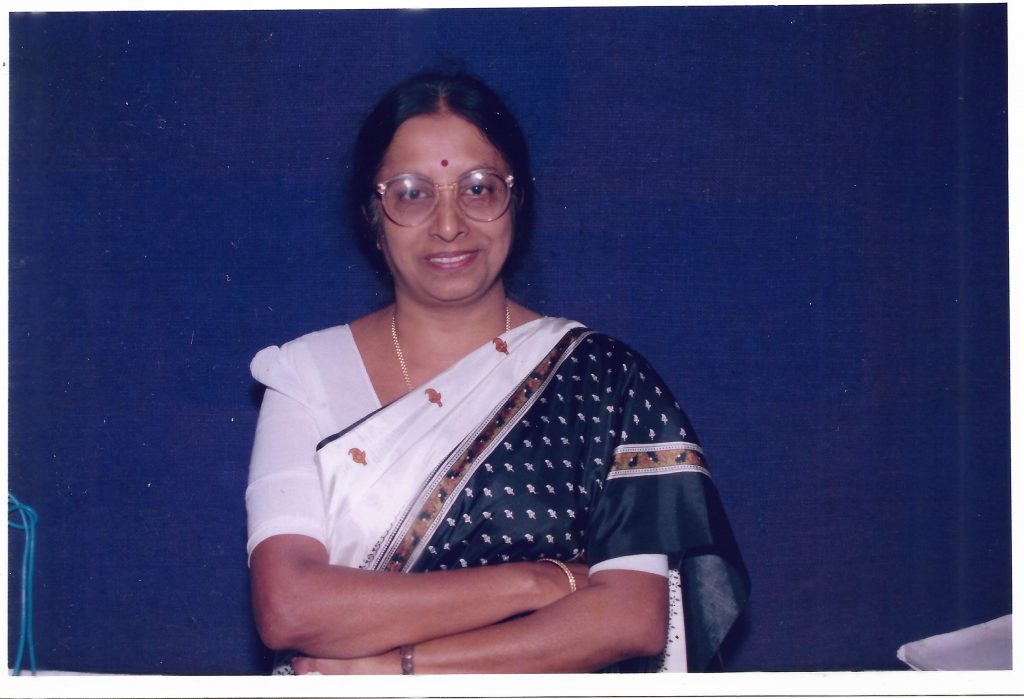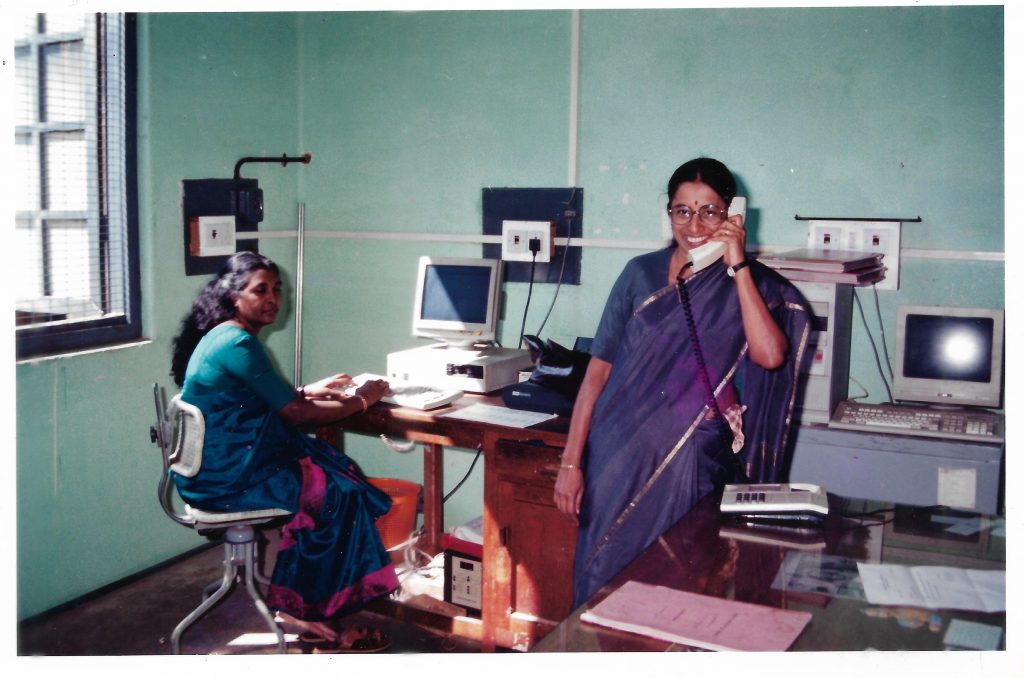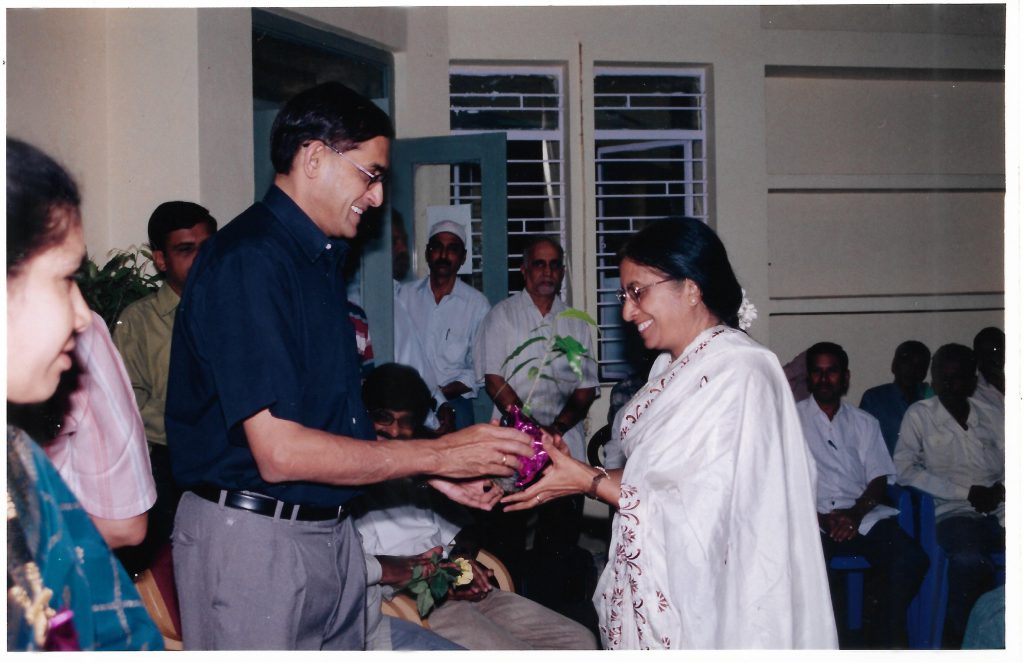Moving from serene Coorg to bustling Bangalore, Ranganayaki Mallur Krishnaswamy forged a career path unusual for women in her time. Born to a renowned veterinary doctor in Coorg in 1948, she finished her schooling in Pollibetta Taluk and later completed a Pre-University Course (PUC) in the small town of Virajpet, Karnataka. Despite the challenges of pursuing education in this remote region, she aspired to work in civil engineering. She then pursued a Diploma in Civil Engineering Draughtsmanship at the Government Women’s Polytechnic College in Bangalore, carving a niche for herself in the once male-dominated field. She joined IISc in 1976 as a draughtswoman in the Department of Civil Engineering, where she worked for 27 years.
Now 75, she speaks to CONNECT about her career, memories of family, and life after retirement.

It is wonderful that you spent your childhood in Coorg. Tell us more about it.
My father was a dedicated veterinary doctor with the forest department, specialising in treating elephants in Coorg. In those days, there was a method to capture elephants called ‘khedda’ that would cause grievous injuries to some elephants. My father tended to these magnificent animals, nursing them back to health. I recall those early experiences with awe and fondness. This was the time my fascination with the natural world and its inhabitants began to take root.
A strong memory I have of my father is from 1958 when he received a special invitation to visit the Taronga Zoo in Sydney, Australia. The Indian Government had gifted an elephant calf from Coorg to the Zoo, and my father, accompanied by one mahout, embarked on a journey by ship to take this creature to its new home.
When my son, Tejas, visited Sydney a few years ago, he mentioned that the zoo’s archives still preserve some photos from that time, of my father, the ship, the lorry transporting the elephant, and even the first encounter between an Australian woman and the adorable calf.
After your diploma in civil engineering, how did you begin your career?
I worked for over six years at Chandavarkar and Thacker, an architecture firm in Bangalore. I had responded to an advertisement for a draughtsman position. Unfortunately, it was not referred to as a draughtswoman (laughs). Following an interview and a meticulous drafting test, I was fortunate enough to be offered the job.
‘I had responded to an advertisement for a draughtsman position. Unfortunately, it was not referred to as draughtswoman’
When did you think of joining IISc?
IISc was not unfamiliar to me. My late cousin, Shashikala Krishnswamy, worked in the Molecular Biophysics Unit. I was aware of IISc’s reputation as a premier institution for research and higher education, and so I felt drawn to being part of such a community.
In January 1976, I stepped into the world of IISc. Little did I know that this journey would span almost three decades, giving me invaluable experiences and opportunities for growth. After joining the Department of Civil Engineering, I found myself as the sole woman staff member. I formed connections with other women students within our department, creating a supportive network. I also developed a close friendship with the late Rajeswari Chatterjee, a professor and later chairperson of the Department of Electrical Communication Engineering (ECE).
Tell us more about your bond with Rajeswari Chatterjee.
I had the privilege of having a close association with her during her tenure. She held the distinction of being the first woman engineer to be appointed on the faculty of IISc. After her retirement, I collaborated with her on several illustrations for a few books that she authored.
I often accompanied Rajeswari to various places; she enjoyed conversing with me, and I was her constant companion (chuckles). Our journeys together included visits to many friends in and around Bangalore, as she had a keen interest like me in literature, including works by SL Bhyrappa.
One particularly memorable experience was when she invited me to accompany her to a conference at Cochin University that lasted for eight days. At the time, there was a railway and airline strike, prompting us to go on a road trip to Cochin. The university had arranged comfortable accommodations, and while she attended the conference, she encouraged me to explore the city.

How did you like your work at IISc?
I started my professional journey in the Department of Civil Engineering, dedicating two decades to the field. In 1995, I transitioned to the Central Workshop, later rebranded as the Centre for Product Design and Manufacturing or CPDM (now it is the Department of Design and Manufacturing). My role as a draughtswoman was central to the preparation of figures, machine drawings, and plans for building components in an era before the prevalence of tools like MS Excel and AutoCAD.
In those days, hand-drawing figures and preparing visuals for presentations were an integral part of academic life. I also assisted professors during consultations, contributing to reinforcement detail drawings and other civil engineering sketches crucial for on-site execution.
‘In those days, hand-drawing figures and preparing visuals for presentations were an integral part of academic life’
I had to balance the demands of raising two children alongside my professional responsibilities. After five years of joining IISc, I achieved a significant milestone as one of the first supporting staff members to pass a promotional exam conducted by IISc. However, despite subsequent promotions, my job role and title remained constant until my retirement.
My time at IISc allowed me to forge enduring friendships, and witness colleagues from the department complete PhDs and some of them even returned as professors. Transitioning to CPDM, I had the privilege of attending classes with the inaugural batch of MDes students, creating cherished memories.
Did you have any additional responsibilities other than draughtswoman work?
I had several administrative duties, such as managing the library at the Department of Civil Engineering, where I ensured the organisation and accessibility of resources for students and faculty.
I also helped create an annual calendar. This involved designing and producing the calendars that became essential fixtures under the glass sheets on individual desks. I also actively helped my colleagues during busy times – particularly during interviews and conferences – coordinating schedules, managing logistics, and providing general assistance.

How has the Institute changed during your tenure?
IISc has always shown a commitment to excellence in research and education. The collaborative environment and the constant pursuit of knowledge made my years both fulfilling and enriching. From the precision of drafting to the intricate details of various projects, each day presented new challenges and learning experiences.
Over the years, I also had the opportunity to see several dignitaries, including Prince Charles, JRD Tata, Rajiv Gandhi, and APJ Abdul Kalam, during their visits to the Institute. I recall attending notable events, including the opening of the JN Tata Auditorium; JRD Tata’s inspiring speech at the event left a lasting impact on me. I also feel great about serving the Institute during Satish Dhawan’s tenure as the director.
Students, faculty, and staff – we were all quite close and we celebrated various milestones together. From monthly outings on paydays to celebrating thesis submissions and colleagues’ weddings, these shared moments added a special charm to our professional lives. March 2003 marked the end of this chapter, but the memories and the impact of those 27 years remain etched in my mind.
‘From monthly outings on paydays to celebrating thesis submissions and colleagues’ weddings, these shared moments added a special charm to our professional lives’
How do you feel about the IISc campus now?
After visiting the campus recently this year, I was heartened to see that it has changed a lot. Earlier, women faculty and staff were scarce, but now there’s a thriving community of female academics and students. This reflects a positive evolution towards inclusivity and gender diversity within the academic setting.
However, I also noticed there has been an increase in new buildings, and diminishing of greenery, giving way to a more urbanised environment. The increased prevalence of two-wheelers on the streets has also rendered the campus less pedestrian-friendly, particularly for senior citizens. I hope that the Institute prioritises restoring a pedestrian-friendly and serene atmosphere.
What was the reason for you to go on voluntary retirement?
The emergence of computers rendered the role of a draughtswoman obsolete, and I found myself at a crossroads. To adapt, I tried to join this new technology wave by participating in the labs of the newly introduced Master of Design (MDes) programme. But my lack of training in sophisticated tools and software, such as AutoCAD, hindered my transition to these contemporary practices.
Unfortunately, I struggled to align my expertise with the rapidly changing professional environment, even though I tried to acquire new skills in order to stay relevant. I had to make a difficult decision. With about six years of service left behind at the institute, I chose to retire in 2003.

Your son is also a faculty member now at IISc, right?
Yes, I am a mother of two sons. My older son, Tejas, is a faculty member in the Department of Civil Engineering at IISc.
How are you spending your retirement?
Retirement did not mark the end of my professional journey. I committed myself to mastering AutoCAD, and continued to work with an architect for several more years.
Post-retirement, I spent 6-8 months living in the USA with my son. During that time, I discovered a new passion for quilting. I now create commissioned quilts and share my knowledge by teaching quilting. Participating in exhibitions has allowed me to showcase and sell my creations. I also enjoy travelling to nearby places with my friends, taking care of my dogs, and fully enjoying my retired life.
Kavitha Harish is Personal Assistant to the Assistant Registrar (HR, Council)




